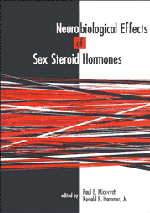Book contents
- Frontmatter
- Contents
- List of contributors
- Dedication
- Preface
- Acknowledgments
- Part I Sex steroid–responsive circuits regulating male and female reproductive behaviors
- Part II Sex steroid interactions with specific neurochemical circuits
- 5 Ovarian steroid interactions with hypothalamic oxytocin circuits involved in reproductive behavior
- 6 Sex steroid regulation of hypothalamic opioid function
- 7 Effects of sex steroids on the cholecystokinin circuit modulating reproductive behavior
- 8 Cholinergic regulation of female sexual behavior
- 9 Sex steroid regulation of tachykinin peptides in neuronal circuitry mediating reproductive functions
- 10 Dopaminergic influences on male rat sexual behavior
- 11 Studying neurotransmitter systems to understand the development and function of sex differences in the brain: the case of vasopressin
- Part III Cellular and molecular mechanisms regulated by sex steroids
- Index
11 - Studying neurotransmitter systems to understand the development and function of sex differences in the brain: the case of vasopressin
Published online by Cambridge University Press: 15 October 2009
- Frontmatter
- Contents
- List of contributors
- Dedication
- Preface
- Acknowledgments
- Part I Sex steroid–responsive circuits regulating male and female reproductive behaviors
- Part II Sex steroid interactions with specific neurochemical circuits
- 5 Ovarian steroid interactions with hypothalamic oxytocin circuits involved in reproductive behavior
- 6 Sex steroid regulation of hypothalamic opioid function
- 7 Effects of sex steroids on the cholecystokinin circuit modulating reproductive behavior
- 8 Cholinergic regulation of female sexual behavior
- 9 Sex steroid regulation of tachykinin peptides in neuronal circuitry mediating reproductive functions
- 10 Dopaminergic influences on male rat sexual behavior
- 11 Studying neurotransmitter systems to understand the development and function of sex differences in the brain: the case of vasopressin
- Part III Cellular and molecular mechanisms regulated by sex steroids
- Index
Summary
Introduction
For neuroscientists, the study of sex differences in the brain promises at least two benefits. Investigations of their development can elucidate the processes that form brain structure during ontogeny that generates specific functions and behaviors, while investigations of the functional significance of these sex differences can reveal how brain morphology and function are related. Except for the fact that sex-related differences in the number of spinal motoneurons have been linked to sex-related differences in the number of specific muscle cells (Kelley 1988; Breedlove 1992), these benefits have been difficult to achieve, however. The complexity of the neuroanatomical connections to and from the brain regions where these differences are found and technical difficulties in manipulating specific sexually dimorphic elements in these areas have delayed the desired result.
This complexity, however, can be exploited. Given that all brain areas contain heterogeneous populations of cells and inputs, focusing on the neurotransmitter content of cells and inputs could reveal whether sexual differentiation selectively affects particular cell populations. This, in turn, could facilitate our understanding of the cellular processes underlying differentiation. Focusing on the neurotransmitter content may also help to reveal the anatomical connections of sexually dimorphic areas, and therefore to assess the impact of a particular dimorphism on other brain areas. Finally, knowing the neurotransmitter systems involved would allow specific manipulation of sexually dimorphic elements by applying specific agonists and antagonists (De Vries 1990).
- Type
- Chapter
- Information
- Neurobiological Effects of Sex Steroid Hormones , pp. 254 - 278Publisher: Cambridge University PressPrint publication year: 1995
- 6
- Cited by

